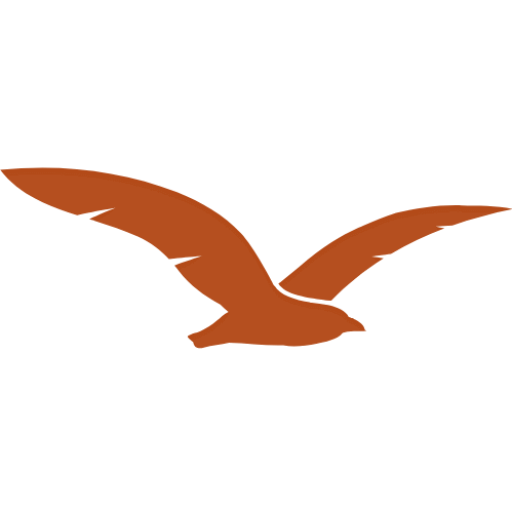This world is plain of birds and predators some of these are falcons and hawks which refer to two species of birds of prey that are known for their exceptional hunting skills and eating every small creature in their environment. Many people when they hear Falcon or hawk conjure many common points and don’t know how to differentiate between them.
8 differences between Falcon and Hawk [Explained]
For this, we decided in this article to talk about the differences between Falcons and Hawks moreover explain every difference point about those species.
1-Physical Size:
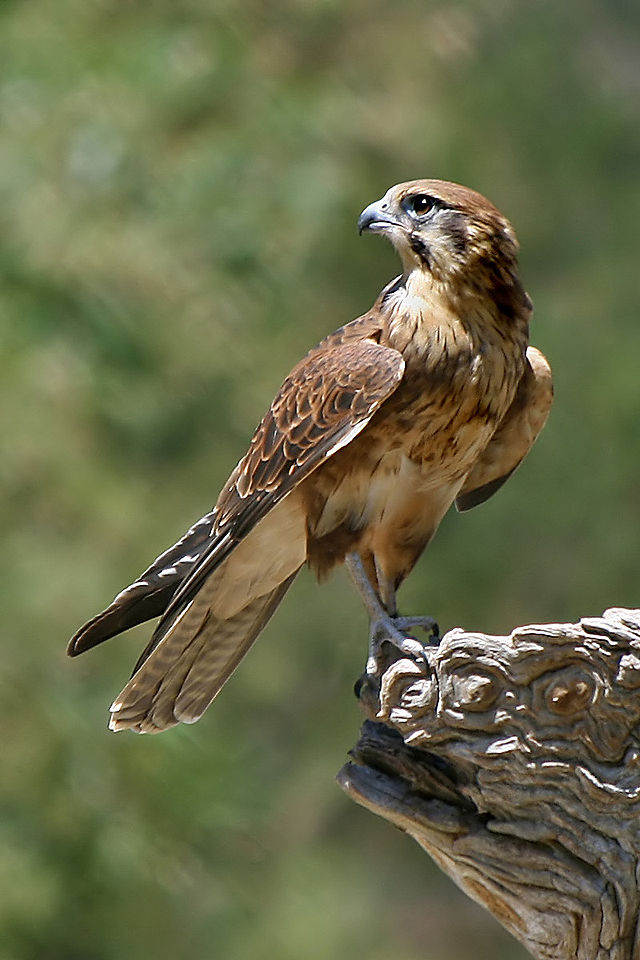
The main and clear difference between falcons and hawks is their size. Furthermore, both their females are larger than males, and falcons are considered smaller than hawks as the male length from the head to tail is 14.2 to 19.3 inches, and the wingspan is 35 to 42 inches as well as 17.7 to 22.8 inches for females with a wingspan of 42-48 inches.
Hawks are larger than falcons because their male size is 18 to 24 inches and females as we said are 25% bigger than males.
2-Falcon vs. Hawks: Color
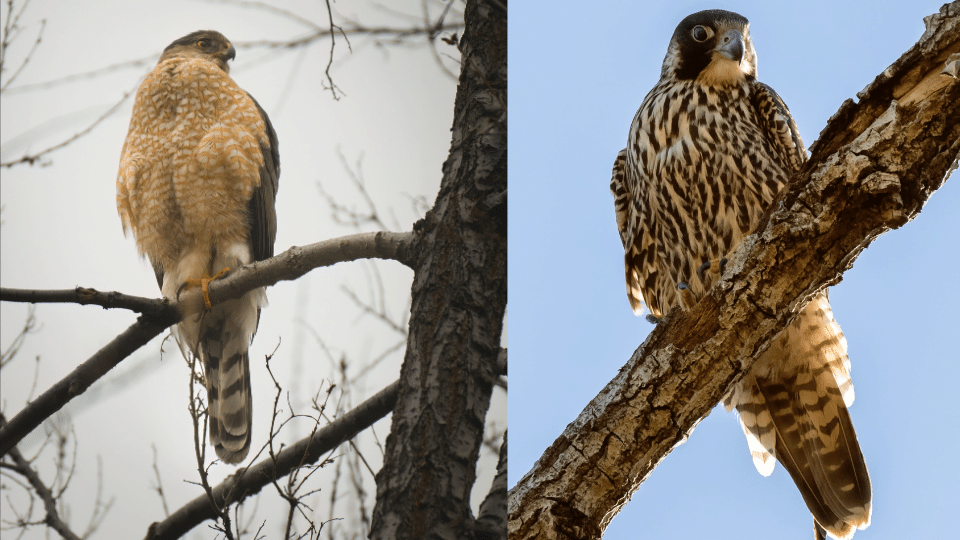
Many people watch both hawks and falcons look similar in color but they think there are no differences and it’s hard for them to distinguish. here are some different keys :
Falcons tend to have more uniform and striking plumage coloration. Many falcon species exhibit a blue-gray or slate-gray upper body with a white or cream-colored underside for example peregrine falcons. This creates a sharp contrast in their appearance. Some falcons may also have black markings, such as a black “malar stripe” or “mustache,” which adds to their distinctive look.
Hawks can display a broader range of plumage colors and patterns. Some hawks, like the red-tailed hawk, have a brown or rufous upper body with a pale underside. Others, like the Cooper’s hawk, may have gray or blue-gray plumage with fine barring or streaking. The plumage of hawks can vary significantly depending on the species, but they generally lack the stark color contrast seen in falcons.
3-Falcon vs. Hawks: Wings
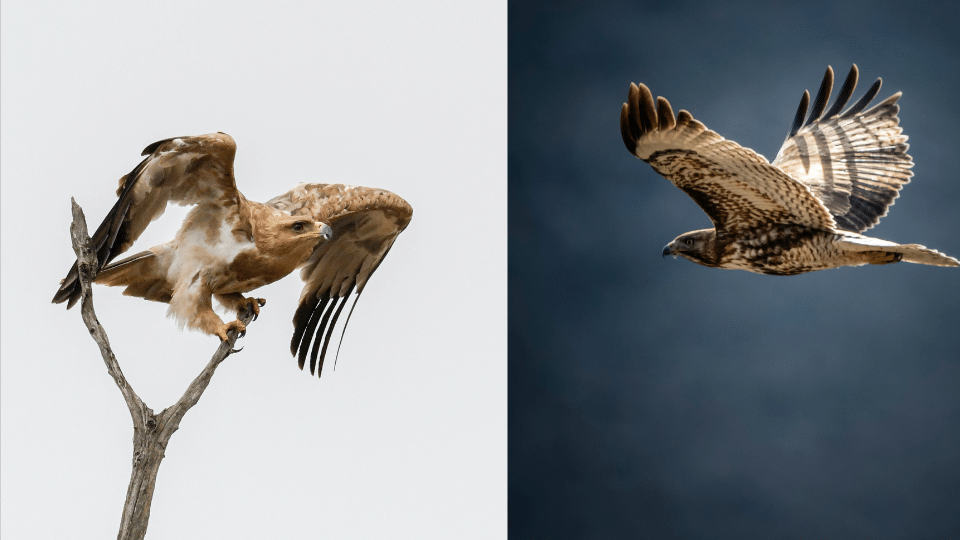
Take a moment to check out those wings – they’re like a telltale sign of who’s who in the bird world! Just a casual look, and you’ll spot the hawk and falcon wings standing out in their own way.
Hawks, they’ve got those wings that are kind of on the shorter side, and they’re wide and curvy like they’re giving you a little birdie hug. Now, when it comes to falcons, it’s all about the long, sleek look. Their wings stretch out, and they come to be nice, pointy tip. You can almost imagine them slicing through the air with those sharp ends.
4-Falcon vs. Hawk: Head shape
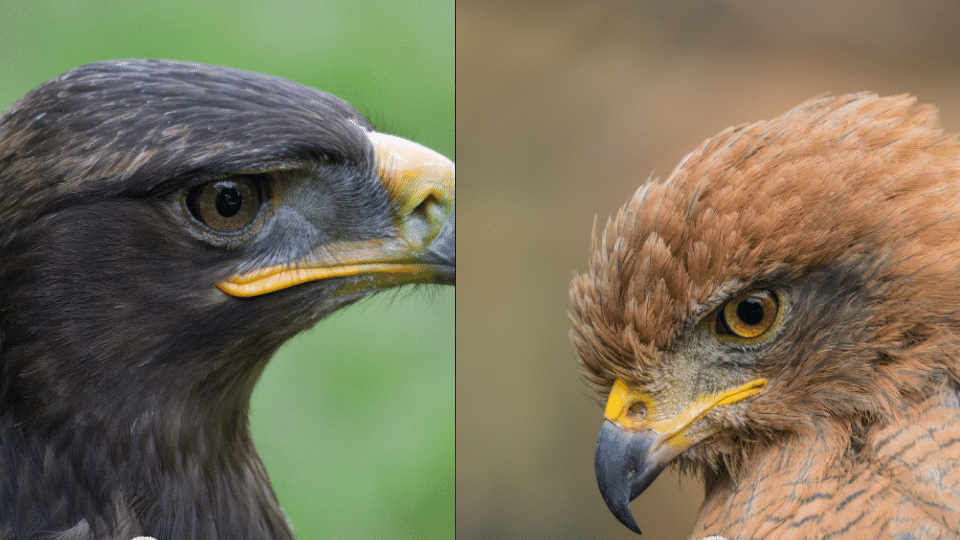
When you first lay your eyes on a hawk and a falcon, it’s easy to assume they’ve got similar-looking heads. But, here’s the catch – the real story unfolds when you get up close and personal. If you strip away the beak and focus solely on the head’s outline, that’s when you’ll notice the subtle yet significant differences.
The hawk, it’s got this head that’s all about elegance. It’s slender, almost like a pointed arrowhead, gracefully cutting through the sky. On the other hand, the falcon’s head takes a different approach. It’s got a rounder, more compact shape like it’s built for speed and precision. So, while they might seem alike from afar, their distinct head shapes tell a unique tale up close.
5-Falcon vs. Hawk: Taxonomy
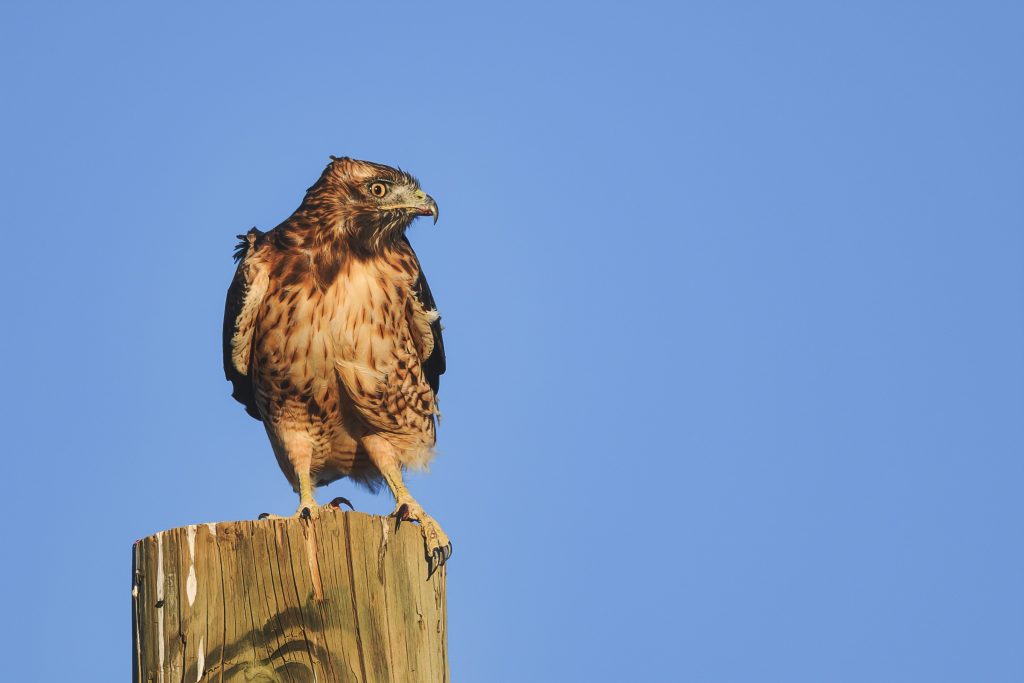
Hawks are part of the family known as Accipitridae. These birds are kind of like the tough guys of the raptor world, with their solid bodies, wide wings, and not-so-long tails. Inside this family, you’ll find different groups. The Buteo gang is all about those classic hawks and buzzards. They’re the ones you’ll see cruising the skies, especially in open areas. Then there’s the Accipiter crew, home to sharp-shinned hawks, sparrowhawks, and goshawks. These folks are more slender, with long tails, and they’re super agile hunters. Eagles have their own exclusive club under the name Aquila, while harriers hang out in the Circus group.
Now, when it comes to falcons, they’ve got their own family called Falconidae, which makes them a bit distinct from hawks in the taxonomy world. Falcons are like the sleek, fast racers of the bird kingdom. They’ve got those pointy wings and often sport fancy facial markings. Unlike hawks, they don’t belong to the Accipitridae family. Instead, they’ve got their own family. Inside Falconidae, you’ll find different falcon groups, mainly under the Falco genus. This includes kestrels, known for their hovering skills, hobbies that are all about speed, peregrines famous for their high-speed dives during hunting, and sometimes there’s a separate category for hierofalcons or hawk-falcons, each with their own unique hunting styles and characteristics.
6-Falcon vs. Hawk: Killing method
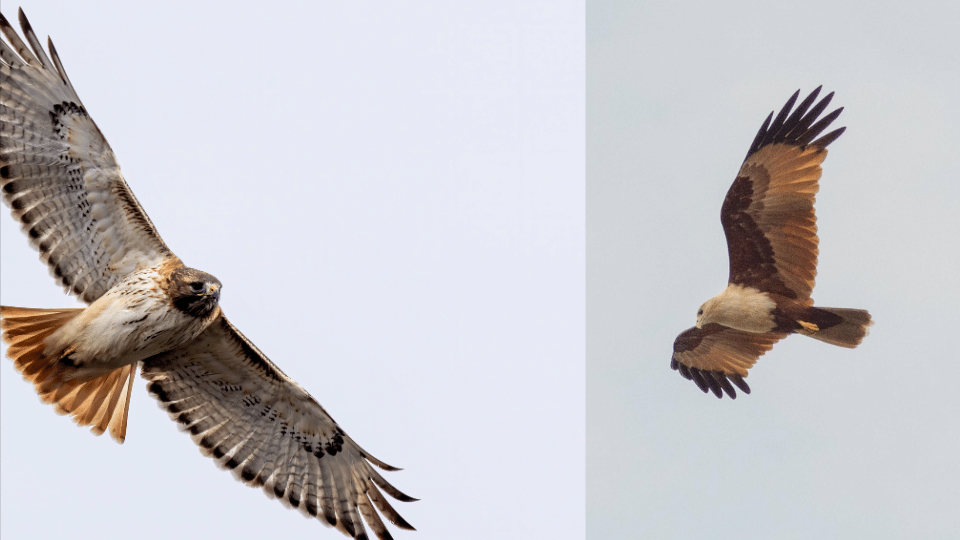
The methods for killing hawks and falcons differ significantly due to their distinct hunting styles and characteristics. When it comes to hawks, one common method of hunting involves using trained birds such as falcons or hawks themselves. Falconers may employ their own birds to pursue and capture hawks that are considered threats to game birds or livestock.
This method relies on the agility and predatory instincts of the trained bird, which is released to chase and capture the offending hawk. Once caught, the trained bird may immobilize the intruder, allowing the falconer to intervene and safely remove the captured hawk from the area.
In contrast, the killing methods for falcons often involve a more solitary approach but they are renowned for their exceptional speed and aerial hunting skills. Falconers typically utilize a trained falcon to hunt prey birds, such as pigeons or waterfowl.
Falcons are released to pursue their prey, and they employ their incredible speed and agility to capture their target mid-flight. Unlike hawks, which may be captured alive for various purposes, falcons are trained to kill their prey swiftly and efficiently, often using their sharp talons to deliver a lethal blow.
This distinction in killing methods reflects the unique hunting behaviors and characteristics of hawks and falcons, with hawks often being captured alive for various purposes while falcons are trained to kill their prey during hunting.
7- Falcon vs. Hawk: Nests

Hawks and falcons choose vastly different locations for their nests. Hawks prefer to build their nests high up in the treetops, a strategic choice that helps protect their nests from potential predators. In contrast, falcons exhibit a bit more flexibility in their nesting preferences. While they do construct nests in tree hollows, they are equally comfortable nesting in bird boxes positioned at heights ranging from ten to thirty feet above the ground.
An examination of the nesting environment can also provide clues to whether a nest belongs to a falcon or a hawk. Hawks tend to favor the upper branches of very tall trees for their nests. On the other hand, falcons are renowned for their adaptability when it comes to nesting sites, including tree branches, cliff ledges, and even human-made structures such as building ledges and bridges. This striking contrast in nesting preferences underscores the unique habitat choices of hawks and falcons in creating their homes.
8- Falcon vs. Hawk: Flying style

The contrasting flying styles of hawks and falcons are a direct reflection of how their wings are designed for distinct purposes. Hawks exhibit a more leisurely flying approach, often fluttering slowly while circling in the sky or, on occasion, using brief flaps followed by gliding.
In stark contrast, falcons are renowned for their speed, capable of reaching speeds of up to 60 miles per hour, whereas hawks generally maintain a slower pace, flying at just under 40 miles per hour. When it comes to hunting, falcons rely on their powerful beaks to tear prey apart, whereas hawks employ their sharp talons or claws for attacking.
The physical appearance of their wings further highlights these differences; falcons sport long and slender wings that are ideal for high-speed maneuvers, leading to rapid, intense flapping and the ability to achieve speeds exceeding 100 miles per hour. In the case of the peregrine falcon, it can even dive at astounding speeds ranging from 180 to 200 miles per hour, showcasing the incredible adaptability of these birds in the art of flight.
Falcon vs Hawk: Tail
There is a different in tails between falcon and hawk as falcon tail looks long and narrow like a sharp triangle which helps it to fly fast and change its directions to hunt easily. In the other hand we can see that hawks tails are broader and rounded, like a fan. it makes it soar through the air with a complete stability.
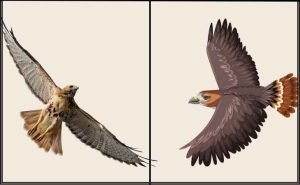
Is A falcon stronger than a Hawk?

The strength of a falcon compared to a hawk cannot be generalized as simply “stronger” or “weaker” because it depends on various factors, including the specific species of falcon and hawk being compared, as well as the context in which their strength is being evaluated.
Falcon species, such as the peregrine falcon, are renowned for their incredible speed and diving abilities. They are among the fastest birds in the world and possess powerful beaks for tearing prey apart. Peregrine falcons, for example, are known for their ability to strike prey in mid-air at high speeds.
Hawks, on the other hand, are a diverse group of birds with various species, and their strengths can vary. Some hawks are known for their exceptional vision, keen hunting instincts, and strong talons for grasping prey.
In terms of physical strength, both falcons and hawks are well-suited to their respective hunting styles. Falcons are built for speed and precision, while hawks are adapted for stealth and ambush. The relative strength of one over the other depends on the specific characteristics and adaptations of the particular species within each group.
So, it’s not accurate to make a blanket statement that falcons are universally stronger than hawks or vice versa. Each species of falcon and hawk has evolved its own set of strengths and abilities suited to its ecological niche and hunting style.

